Accounting for Managers: Financial Statement Analysis
VerifiedAdded on 2020/05/16
|7
|755
|58
Homework Assignment
AI Summary
This assignment analyzes the financial performance of Myer, an Australian department store chain, using its financial statements from 2015 and 2016. The student examines revenue recognition, valuation methods for property, plant, and equipment, and the role of PricewaterhouseCoopers as the independent auditor. The assignment calculates and interprets various financial ratios, including inventory turnover, accounts receivable turnover, profit margin, gross profit margin, debt ratio, and interest coverage ratio. The analysis reveals trends in profitability, efficiency, and financial health, highlighting improvements or declines in Myer's performance over the two-year period. The report also touches on Myer's ethical sourcing policies and sustainability efforts.
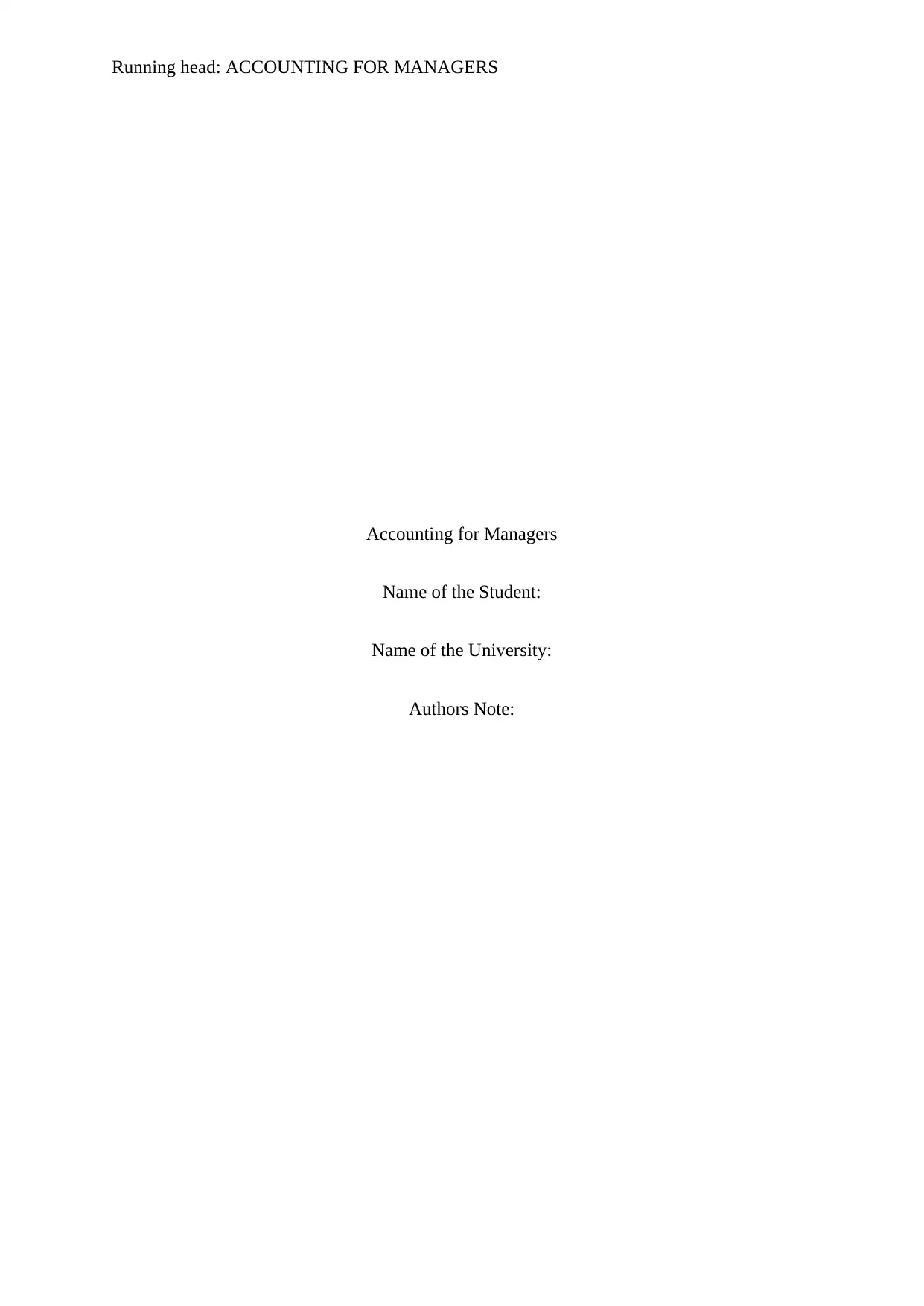
Running head: ACCOUNTING FOR MANAGERS
Accounting for Managers
Name of the Student:
Name of the University:
Authors Note:
Accounting for Managers
Name of the Student:
Name of the University:
Authors Note:
Paraphrase This Document
Need a fresh take? Get an instant paraphrase of this document with our AI Paraphraser
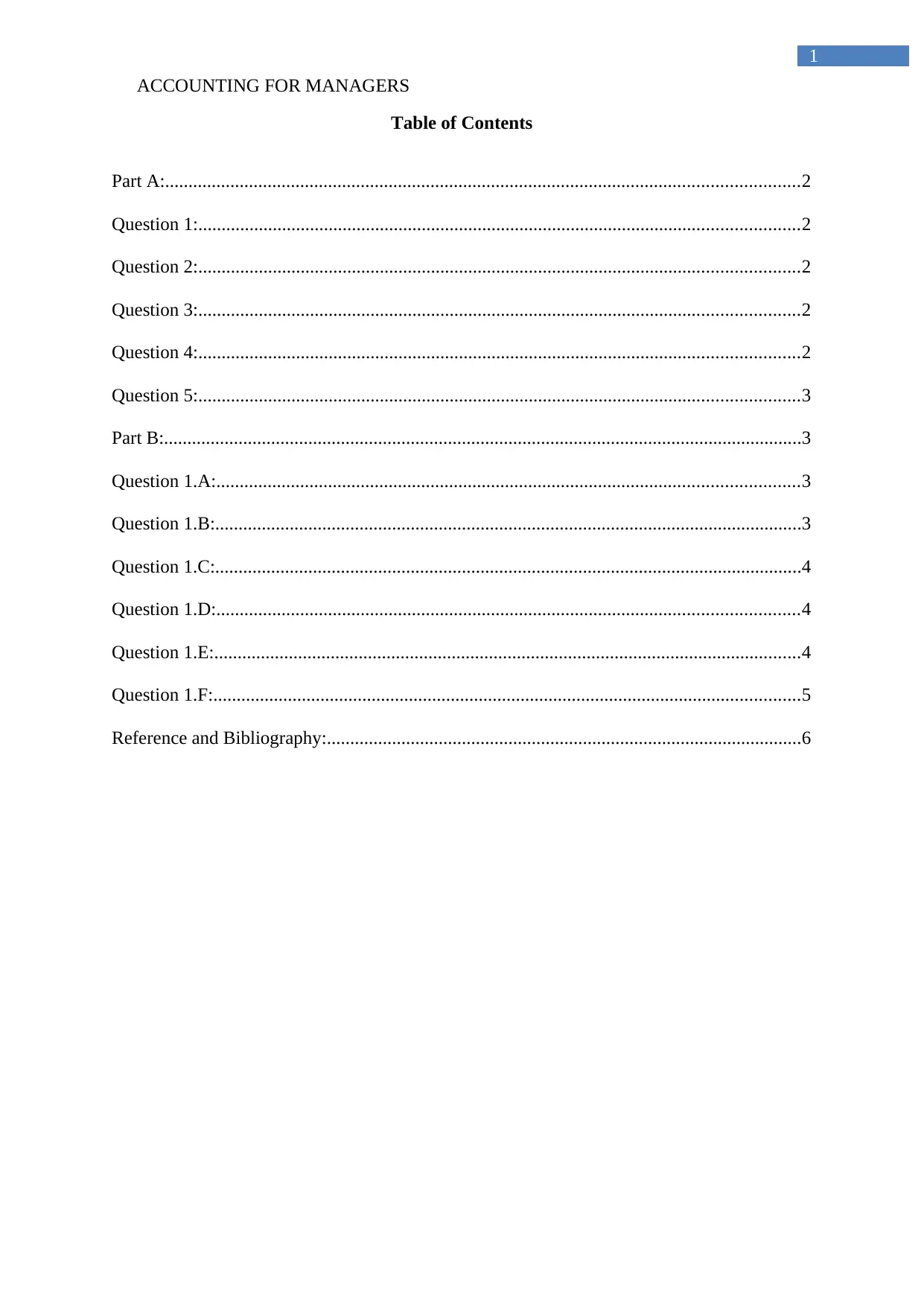
ACCOUNTING FOR MANAGERS
1
Table of Contents
Part A:........................................................................................................................................2
Question 1:.................................................................................................................................2
Question 2:.................................................................................................................................2
Question 3:.................................................................................................................................2
Question 4:.................................................................................................................................2
Question 5:.................................................................................................................................3
Part B:.........................................................................................................................................3
Question 1.A:.............................................................................................................................3
Question 1.B:..............................................................................................................................3
Question 1.C:..............................................................................................................................4
Question 1.D:.............................................................................................................................4
Question 1.E:..............................................................................................................................4
Question 1.F:..............................................................................................................................5
Reference and Bibliography:......................................................................................................6
1
Table of Contents
Part A:........................................................................................................................................2
Question 1:.................................................................................................................................2
Question 2:.................................................................................................................................2
Question 3:.................................................................................................................................2
Question 4:.................................................................................................................................2
Question 5:.................................................................................................................................3
Part B:.........................................................................................................................................3
Question 1.A:.............................................................................................................................3
Question 1.B:..............................................................................................................................3
Question 1.C:..............................................................................................................................4
Question 1.D:.............................................................................................................................4
Question 1.E:..............................................................................................................................4
Question 1.F:..............................................................................................................................5
Reference and Bibliography:......................................................................................................6
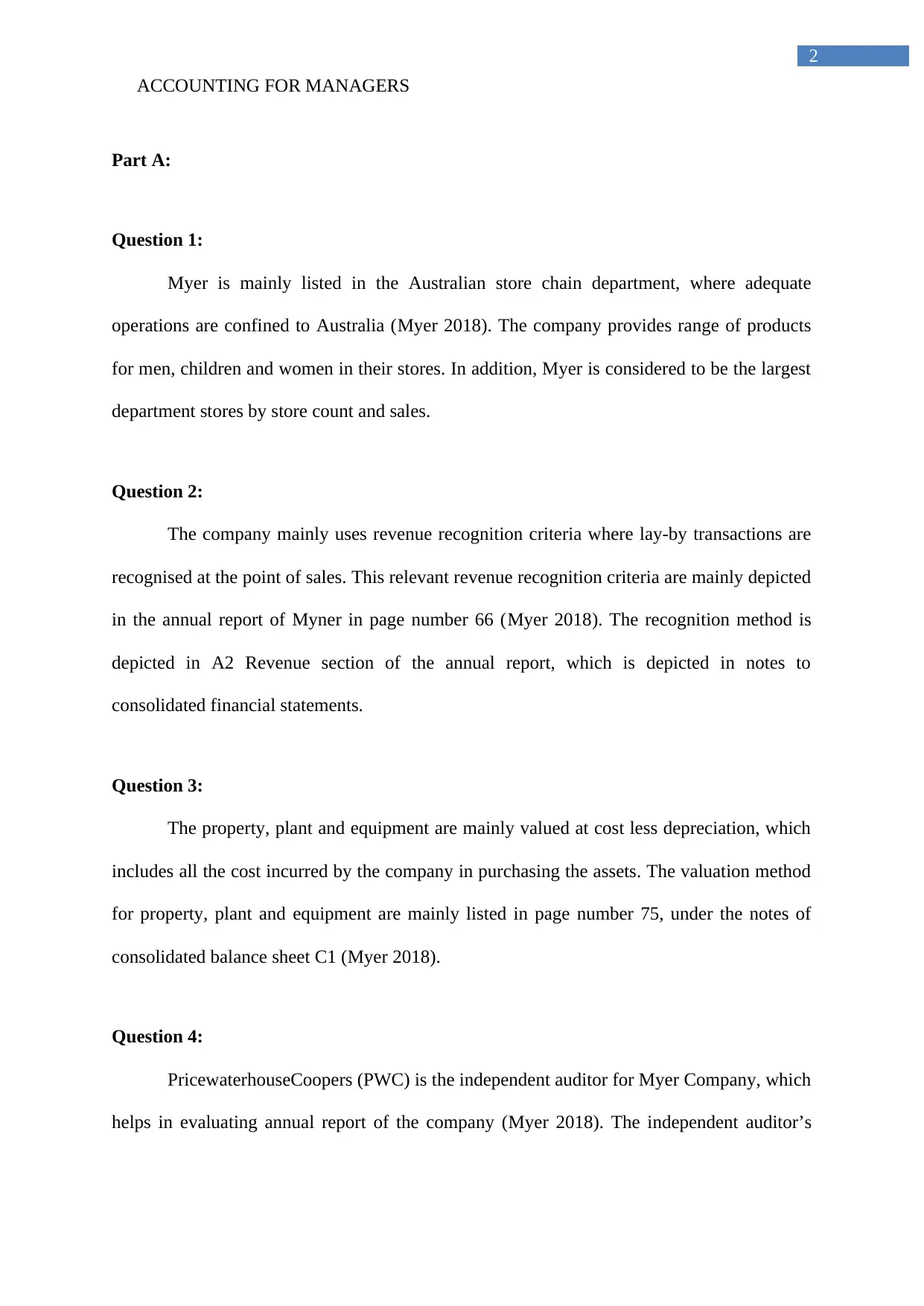
ACCOUNTING FOR MANAGERS
2
Part A:
Question 1:
Myer is mainly listed in the Australian store chain department, where adequate
operations are confined to Australia (Myer 2018). The company provides range of products
for men, children and women in their stores. In addition, Myer is considered to be the largest
department stores by store count and sales.
Question 2:
The company mainly uses revenue recognition criteria where lay-by transactions are
recognised at the point of sales. This relevant revenue recognition criteria are mainly depicted
in the annual report of Myner in page number 66 (Myer 2018). The recognition method is
depicted in A2 Revenue section of the annual report, which is depicted in notes to
consolidated financial statements.
Question 3:
The property, plant and equipment are mainly valued at cost less depreciation, which
includes all the cost incurred by the company in purchasing the assets. The valuation method
for property, plant and equipment are mainly listed in page number 75, under the notes of
consolidated balance sheet C1 (Myer 2018).
Question 4:
PricewaterhouseCoopers (PWC) is the independent auditor for Myer Company, which
helps in evaluating annual report of the company (Myer 2018). The independent auditor’s
2
Part A:
Question 1:
Myer is mainly listed in the Australian store chain department, where adequate
operations are confined to Australia (Myer 2018). The company provides range of products
for men, children and women in their stores. In addition, Myer is considered to be the largest
department stores by store count and sales.
Question 2:
The company mainly uses revenue recognition criteria where lay-by transactions are
recognised at the point of sales. This relevant revenue recognition criteria are mainly depicted
in the annual report of Myner in page number 66 (Myer 2018). The recognition method is
depicted in A2 Revenue section of the annual report, which is depicted in notes to
consolidated financial statements.
Question 3:
The property, plant and equipment are mainly valued at cost less depreciation, which
includes all the cost incurred by the company in purchasing the assets. The valuation method
for property, plant and equipment are mainly listed in page number 75, under the notes of
consolidated balance sheet C1 (Myer 2018).
Question 4:
PricewaterhouseCoopers (PWC) is the independent auditor for Myer Company, which
helps in evaluating annual report of the company (Myer 2018). The independent auditor’s
⊘ This is a preview!⊘
Do you want full access?
Subscribe today to unlock all pages.

Trusted by 1+ million students worldwide
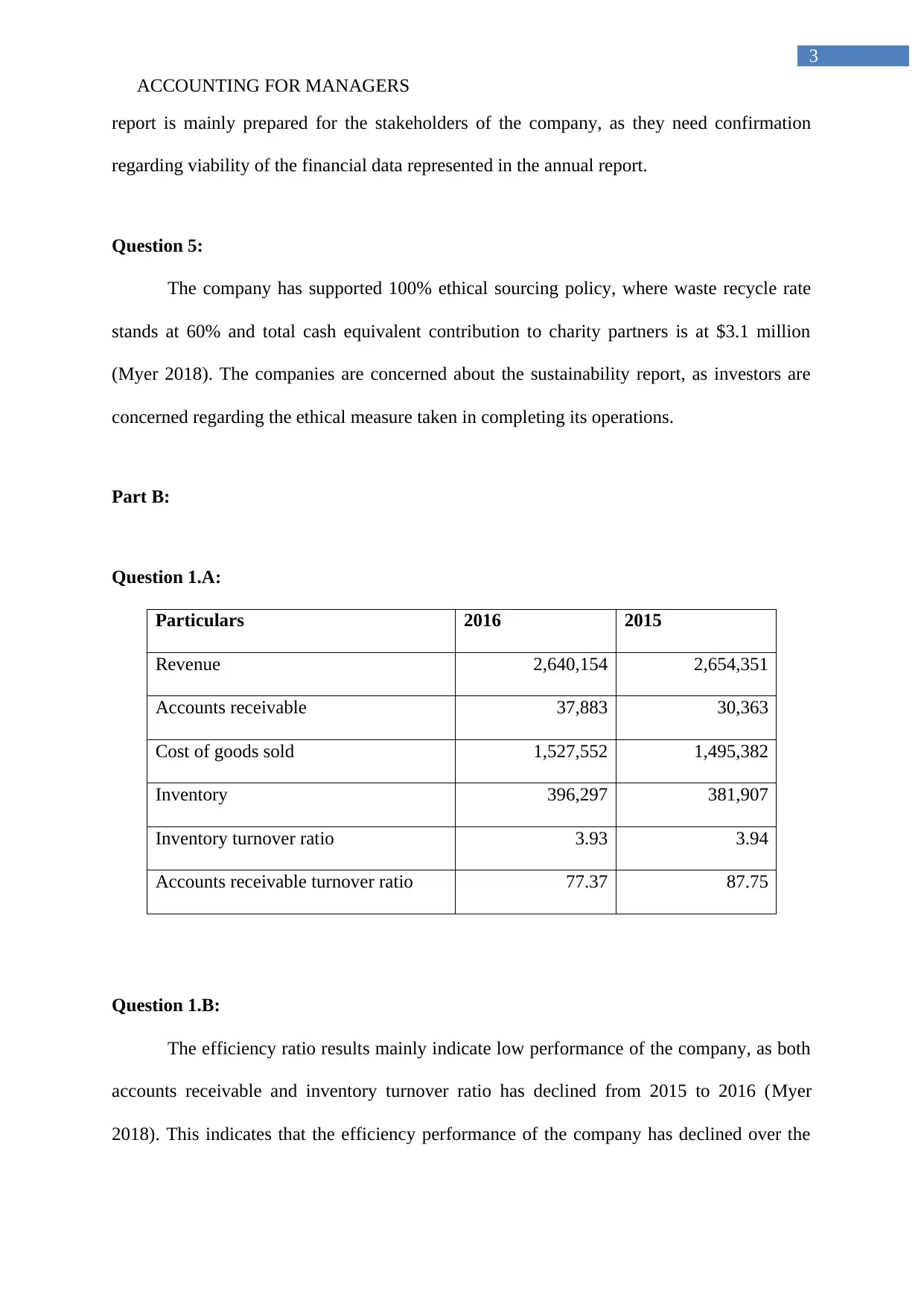
ACCOUNTING FOR MANAGERS
3
report is mainly prepared for the stakeholders of the company, as they need confirmation
regarding viability of the financial data represented in the annual report.
Question 5:
The company has supported 100% ethical sourcing policy, where waste recycle rate
stands at 60% and total cash equivalent contribution to charity partners is at $3.1 million
(Myer 2018). The companies are concerned about the sustainability report, as investors are
concerned regarding the ethical measure taken in completing its operations.
Part B:
Question 1.A:
Particulars 2016 2015
Revenue 2,640,154 2,654,351
Accounts receivable 37,883 30,363
Cost of goods sold 1,527,552 1,495,382
Inventory 396,297 381,907
Inventory turnover ratio 3.93 3.94
Accounts receivable turnover ratio 77.37 87.75
Question 1.B:
The efficiency ratio results mainly indicate low performance of the company, as both
accounts receivable and inventory turnover ratio has declined from 2015 to 2016 (Myer
2018). This indicates that the efficiency performance of the company has declined over the
3
report is mainly prepared for the stakeholders of the company, as they need confirmation
regarding viability of the financial data represented in the annual report.
Question 5:
The company has supported 100% ethical sourcing policy, where waste recycle rate
stands at 60% and total cash equivalent contribution to charity partners is at $3.1 million
(Myer 2018). The companies are concerned about the sustainability report, as investors are
concerned regarding the ethical measure taken in completing its operations.
Part B:
Question 1.A:
Particulars 2016 2015
Revenue 2,640,154 2,654,351
Accounts receivable 37,883 30,363
Cost of goods sold 1,527,552 1,495,382
Inventory 396,297 381,907
Inventory turnover ratio 3.93 3.94
Accounts receivable turnover ratio 77.37 87.75
Question 1.B:
The efficiency ratio results mainly indicate low performance of the company, as both
accounts receivable and inventory turnover ratio has declined from 2015 to 2016 (Myer
2018). This indicates that the efficiency performance of the company has declined over the
Paraphrase This Document
Need a fresh take? Get an instant paraphrase of this document with our AI Paraphraser
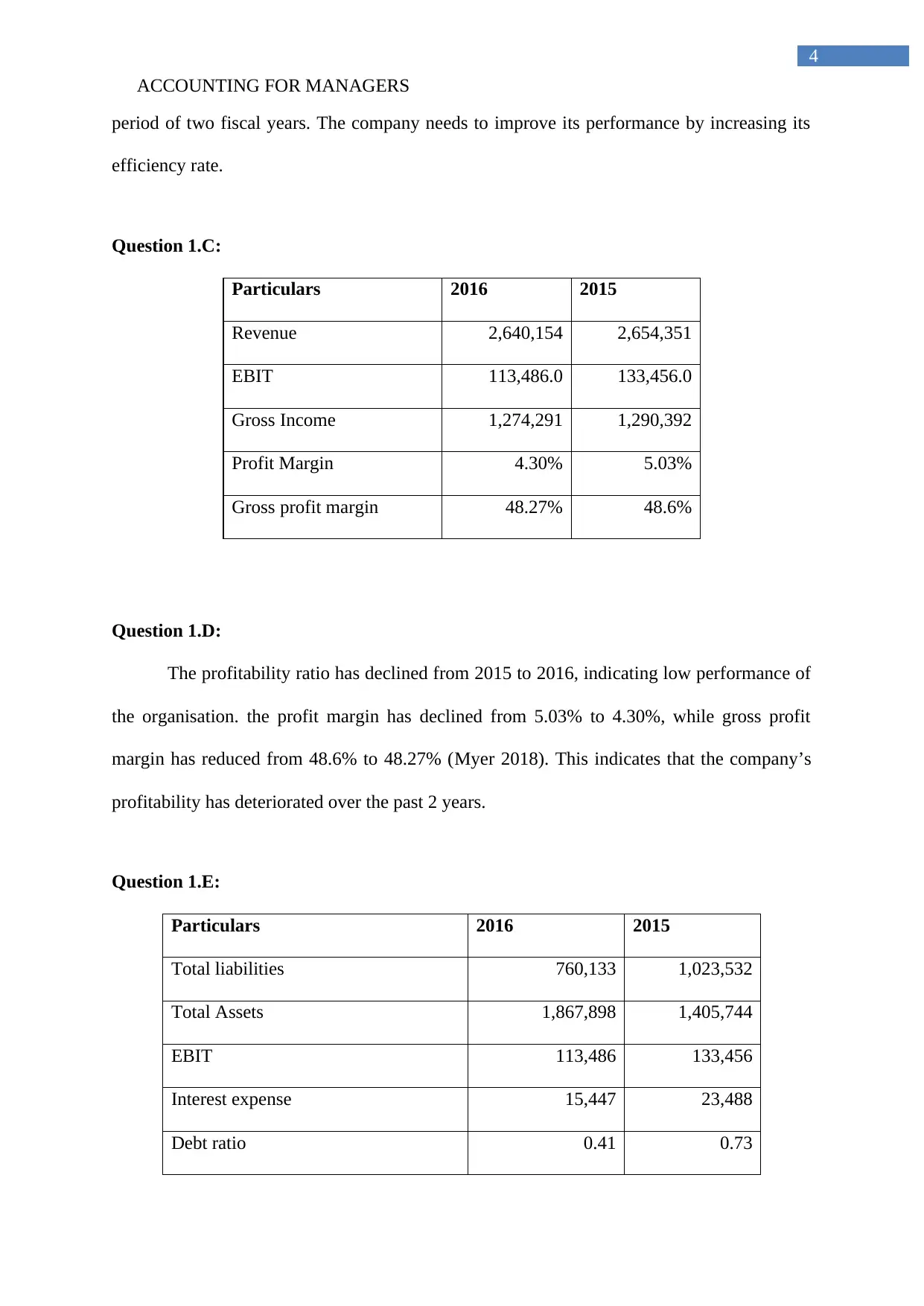
ACCOUNTING FOR MANAGERS
4
period of two fiscal years. The company needs to improve its performance by increasing its
efficiency rate.
Question 1.C:
Particulars 2016 2015
Revenue 2,640,154 2,654,351
EBIT 113,486.0 133,456.0
Gross Income 1,274,291 1,290,392
Profit Margin 4.30% 5.03%
Gross profit margin 48.27% 48.6%
Question 1.D:
The profitability ratio has declined from 2015 to 2016, indicating low performance of
the organisation. the profit margin has declined from 5.03% to 4.30%, while gross profit
margin has reduced from 48.6% to 48.27% (Myer 2018). This indicates that the company’s
profitability has deteriorated over the past 2 years.
Question 1.E:
Particulars 2016 2015
Total liabilities 760,133 1,023,532
Total Assets 1,867,898 1,405,744
EBIT 113,486 133,456
Interest expense 15,447 23,488
Debt ratio 0.41 0.73
4
period of two fiscal years. The company needs to improve its performance by increasing its
efficiency rate.
Question 1.C:
Particulars 2016 2015
Revenue 2,640,154 2,654,351
EBIT 113,486.0 133,456.0
Gross Income 1,274,291 1,290,392
Profit Margin 4.30% 5.03%
Gross profit margin 48.27% 48.6%
Question 1.D:
The profitability ratio has declined from 2015 to 2016, indicating low performance of
the organisation. the profit margin has declined from 5.03% to 4.30%, while gross profit
margin has reduced from 48.6% to 48.27% (Myer 2018). This indicates that the company’s
profitability has deteriorated over the past 2 years.
Question 1.E:
Particulars 2016 2015
Total liabilities 760,133 1,023,532
Total Assets 1,867,898 1,405,744
EBIT 113,486 133,456
Interest expense 15,447 23,488
Debt ratio 0.41 0.73
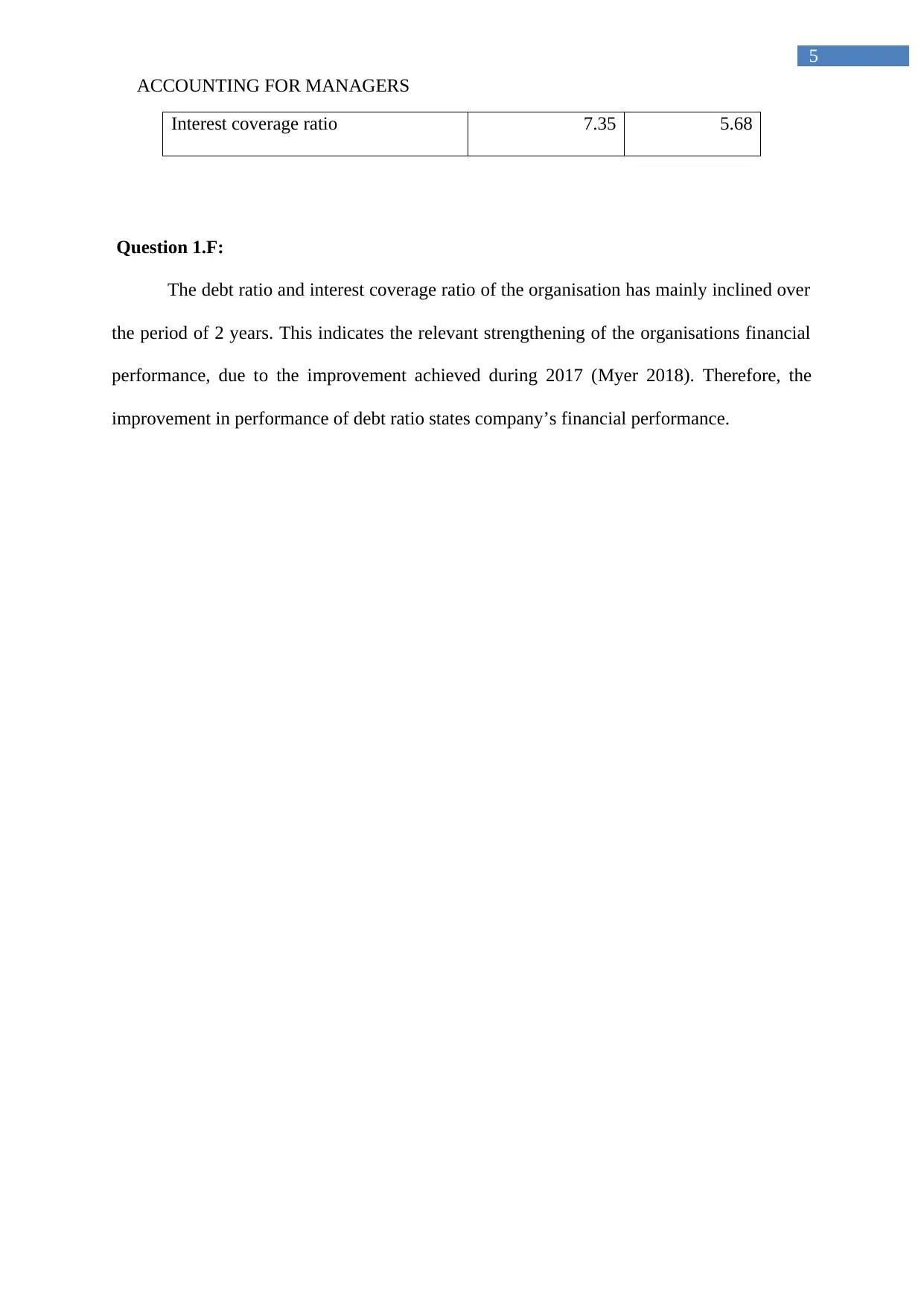
ACCOUNTING FOR MANAGERS
5
Interest coverage ratio 7.35 5.68
Question 1.F:
The debt ratio and interest coverage ratio of the organisation has mainly inclined over
the period of 2 years. This indicates the relevant strengthening of the organisations financial
performance, due to the improvement achieved during 2017 (Myer 2018). Therefore, the
improvement in performance of debt ratio states company’s financial performance.
5
Interest coverage ratio 7.35 5.68
Question 1.F:
The debt ratio and interest coverage ratio of the organisation has mainly inclined over
the period of 2 years. This indicates the relevant strengthening of the organisations financial
performance, due to the improvement achieved during 2017 (Myer 2018). Therefore, the
improvement in performance of debt ratio states company’s financial performance.
⊘ This is a preview!⊘
Do you want full access?
Subscribe today to unlock all pages.

Trusted by 1+ million students worldwide
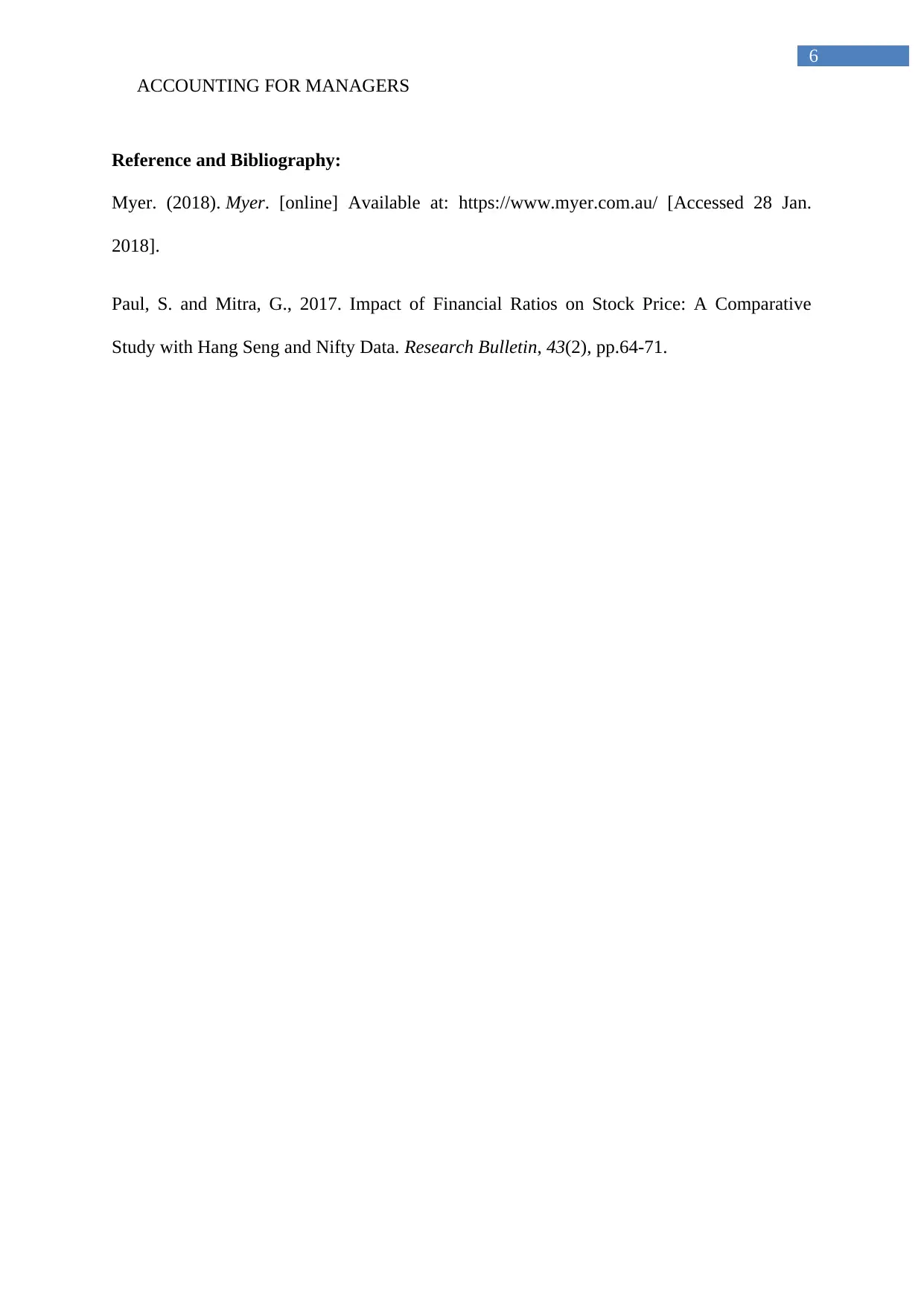
ACCOUNTING FOR MANAGERS
6
Reference and Bibliography:
Myer. (2018). Myer. [online] Available at: https://www.myer.com.au/ [Accessed 28 Jan.
2018].
Paul, S. and Mitra, G., 2017. Impact of Financial Ratios on Stock Price: A Comparative
Study with Hang Seng and Nifty Data. Research Bulletin, 43(2), pp.64-71.
6
Reference and Bibliography:
Myer. (2018). Myer. [online] Available at: https://www.myer.com.au/ [Accessed 28 Jan.
2018].
Paul, S. and Mitra, G., 2017. Impact of Financial Ratios on Stock Price: A Comparative
Study with Hang Seng and Nifty Data. Research Bulletin, 43(2), pp.64-71.
1 out of 7
Related Documents
Your All-in-One AI-Powered Toolkit for Academic Success.
+13062052269
info@desklib.com
Available 24*7 on WhatsApp / Email
![[object Object]](/_next/static/media/star-bottom.7253800d.svg)
Unlock your academic potential
Copyright © 2020–2025 A2Z Services. All Rights Reserved. Developed and managed by ZUCOL.





